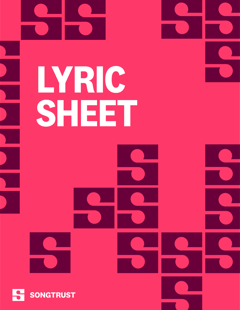To many songwriters, lyrics can feel like the most difficult element of a song to get right. For those of us who come to songwriting from a musical background, words can feel arduous and abstract to manage, where melody and harmonic cadence may come with certainty and control. Even for songwriters who begin with prose, the task of setting those beautiful poetics to melody and groove that enhances their meanings and matches their stress patterns is utterly daunting. Often, what we’re left with is a Frankenstein-patchwork of a creation. Sometimes we just long to simply finish a song where the lyric didn’t totally drive a wedge between us and the joy of writing.
There is hope for anyone feeling lyrically challenged. It comes, as all good skills do, in the form of daily practice. But instead of simply determining to push out lyrics to our songs each day, we can practice a simple tool that sharpens our ability to know a good lyric when we hear one. This is the tool of descriptive writing, and it is the basis of all great story-telling across many mediums.
Descriptive Writing
Creative writers know that a picture paints a thousand words. Audiences lose themselves in the world we create for them when we show it instead of tell about it. Describing a moment in terms of what it looks, sounds, smells, feels, moves, and even tastes like makes the experience come alive. Consider the example below:
She sat slumped against the kitchen cupboards, metal hinges stabbing into her back, robe draped across the floor, cold kitchen tiles pressed against her calves, and hot tears streaking down her cheek.
Now consider this example:
She felt desperate and cold. She was sad, and was overcome with hopelessness.
Both examples describe the same character, but the first shows us the woman while the second just tells us how the woman feels. In one, we’re standing in the midst of the woman and her pain, empathizing with her situation. In the other, we’re merely a bystander. A great rule of thumb in any style of writing is to show before tell. Songwriting is no different.
Showing Language in Lyric Writing
Songs need both showing and telling language, but we may notice that different genres engage the listener with more or less of each. Where a country song might put the listener at the bar, staring down a glass of whiskey on the rocks and stamping out a cigarette, a pop tune might leave us without a clear sense of where and when, so the message is relatable from many different perspectives. Whatever our lyric style and preference, what really matters is that we understand two important concepts:
-
How our lyric writing style matches our musical intent
-
If we’re writing for a commercial purpose, how well our lyric writing style matches the market we’re aiming for
The first step towards getting clear about our match between our musical and lyrical style is to do some digging into what makes each tick. If you’re creating a musical ‘scene’ that begs for a more substantial lyric with showing language, the listener may feel a lack of authenticity in the overall experience. Another way of saying this is your lyrics may come across as ‘cheesy.’
Consider what your listeners tend to appreciate about your songs, and what they compliment you on. These are indicators of what is most powerful about the experience you’re already creating with your music. If you’re not getting the message that your lyrics are a driving element in your songs, learning how to identify and use descriptive language can be key to boosting the listeners emotional engagement in that area. We can even learn to pace descriptive and non-descriptive language to achieve just the right balance to suit a particular genre or artist or pitch purpose.
Sensory Writing in Action
When our lyric writing style is very concrete and literal, it’s likely we’re using a lot of pictures. We set the character in the scene, in a particular moment in time. Like this:
The colds been hanging around this town
in scraps of snow along the road
the ditches are all matted down
like their nursing a bruise from a blow
Driving home at 5am I get time to think
When the stoplights are still asleep on red
you roll in
The lyric puts the singer in a particular time and place. Every time the audience listens to the song, that time and place won’t change. It’s concrete, immovable.
But when our writing style is figurative, abstract, or metaphorical, the time and place is moveable, flexible. Instead of painting the scene, we capture feelings and thoughts, instead:
Do you dream like me?
do you grab the sheets
like the throttle on a jet plane?
When the dark is thick
and your mind is fixed
on how your life’s a mess?
Do you walk the halls
like a prison cell
Spend your hours
in a living hell
or don’t you know the world I know?
Don’t you know the world I know
When we write about feelings and thoughts, we can still use our sensory writing chops —but just towards a different end. We can write about our song concept through the ‘lens’ of something tangible and concrete, so that the lyric has a consistent identity but isn’t tied down by who, when, and where. There is no actual jet in the scene with the singer, and the listener knows that. Yet, the jet is a picture that in this simile, shares the sentiment of power, impulse, passion, and danger that the singer feels when dreaming. What the listener gets is a lyric they can relate to their own experiences, and a lyric that is more easily remembered because the sensory language gives it substance and a distinctive quality.
This kind of lyric writing works beautifully when paired with visual mediums. The lyrics create a vivid experience musically that won’t get in the way of the picture on-screen.
Practice Makes Perfect
The daily practice of sensory writing for 10 minutes is a wonderful action that leads to dramatic results in our lyric writing. Whether we use pictures in our lyrics or not, our ability to dip into showing-language anytime we want strengthens even our assessment of good telling-language. It makes us more discerning about the lines we write and the rhymes we let in. Overall, we’re less likely to make assumptions about what the listener actually understood from our lyrics, and feel confident about the messages we know we’re sending.
Now that you've learned how to draw your listeners in by using sensory language, you can learn how to write killer hooks and keep them coming back for more.
Also, check out Andrea’s free guide: The 5 Songwriting Tools that change everything






